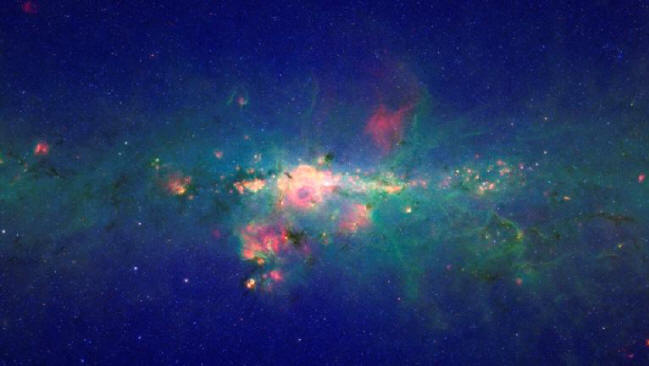|
|
"Hot Hot Hot!"
Dec
15, 2008
The
brightest star is now joined by one
of the hottest. Luminosity and
temperature evaluations ignore the
electric star hypothesis, however.
NASA scientists monitoring the
Far-Ultraviolet Spectroscopic
Explorer (FUSE) recently
announced finding a candidate
for the hottest star ever
discovered. KPD 0005+5106, a "white
dwarf" star, measures an incredible
200,000 degrees Celsius, based on an
analysis of ultraviolet light in the
star's spectrum. In comparison, the
Sun is approximately 6000 degrees
Celsius.
White dwarfs are commonly referred
to as being very hot, exceeding
10,000 degrees, and they are
supposed to be stars near the end of
their lives. If the star was born
with several times the mass of our
own Sun, then it is theorized to
undergo increased heating after it
exhausts its primary nuclear fuel
and to collapse under its own
gravity. Such superheated white
dwarfs are therefore exceedingly
rare, since they are said to pass
through that phase in a short time.
The photosphere of KPD 0005+5106 is
reported to be so intensely hot that
it is glowing in ultraviolet light
frequencies. FUSE researchers say
that the phenomenon has never been
seen before. The statement is not
surprising because "hot gas" does
not normally emit ultraviolet light
unless it is feeding the flame of an
arc welder.
In a previous Picture of the Day
article, a review of the Hertzsprung-Russell
diagram (H-R) demonstrated that
critical information about stellar
environments is ignored when
attempting to classify stars into a
chronological chart. Their births in
a "nebular
cloud" and their deaths from
heat loss or
supernova explosions are
illustrated and their
characteristics codified based on
brightness, redshift and total mass,
but charge density and current flow
are not charted. According to
consensus opinions, this "stellar
main sequence" describes what
happens to stars as they age.
Since astronomers and other
specialists are not mapping the
current flow through space and
its influence on stellar evolution,
they have seriously overstated the
case for the gravitational model of
the cosmos. No information as to the
electrical input or output of the
stars is considered when the various
conventional theories are debated.
By failing to give credence to the
electrical interaction of stars with
their galactic environment, an
entire line of investigation remains
fallow.
In
The Electric Sky, retired
professor of electrical engineering
Dr. Don Scott provides a fresh look
at the plot of stars on the H-R
diagram. Scott proposes that the
mass, temperature and luminosity of
stars are not the only factors that
should be considered when describing
the life cycle of the stars. The
most important factor in any star's
characteristics is the current
density in Amperes per square meter
(A/m2) at the star's surface. If the
incoming current density increases,
the surface gets hotter, radiates
shorter wavelengths (from red toward
blue) and becomes brighter.
Therefore the strength of the
current density impinging into its
surface, and the star's diameter,
are responsible for its absolute
brightness.
Some stars have been found that are
too cool and too small for
atomic fusion to take place. Stars
are supposed to be at least 75 times
the mass of Jupiter for fusion
reactions to occur. Now stars that
are too hot and bright for their
positions in the sequence are
causing astronomers to revisit their
theories of nebular birth. As the
Electric Star hypothesis suggests,
though, by including electricity in
cosmological equations the puzzles
that arise with new observations
will be resolved.
Don Scott: "In the Electric Star
model, there is no minimum
temperature or mass requirement. If
a brown or red dwarf is operating
near the upper boundary of the dark
current mode, any slight increase in
the level of current density
impinging on any portion of the
surface of that star will shift this
plasma into the normal glow mode.
This transition will be accompanied
by a rapid change in the voltage
rise across the plasma of the star's
upper atmosphere. Maxwell's
equations tell us that such a change
in voltage can produce a strong
dynamic electric field and a strong
dynamic magnetic field. If they are
sufficiently intense, dynamic
electromagnetic fields will produce
x-rays. [or ultraviolet - editor]."
By Stephen Smith
|
|
|
|
|
|
SPECIAL NOTE - **New Volumes Available:
We are pleased to announce a new
e-book series
THE UNIVERSE ELECTRIC. Available now, the first volume
of this series, titled Big Bang, summarizes the failure of modern cosmology
and offers a new electrical perspective on the cosmos. At
over 200 pages, and
designed for broadest public appeal, it combines spectacular
full-color graphics with lean and readily understandable
text.
**Then second and third volumes in the series are now available,
respectively titled Sun and Comet, they offer
the reader easy to understand explanations of how and why these bodies
exist within an Electric Universe.
High school and college students--and teachers in
numerous fields--will love these books. So will a large
audience of general readers.
Visitors to the Thunderbolts.info site have often
wondered whether they could fully appreciate the Electric
Universe without further formal education. The answer is
given by these exquisitely designed books. Readers from
virtually all backgrounds and education levels will find them
easy to comprehend, from start to finish.
For the Thunderbolts Project, this series is a milestone.
Please see for yourself by checking out the new
Thunderbolts Project website, our leading edge in
reaching new markets globally.
Please visit our
Forum
|
|
|
|
|
|
|
|







